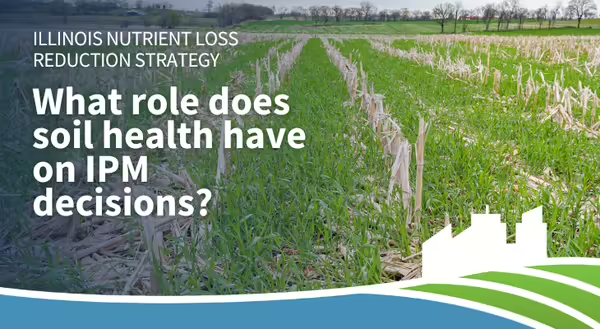
With so many conservation practices focusing on soil health, what impact might those decisions have on your Integrated Pest Management (IPM) decisions? IPM is a science-based decision-making process that combines tools and strategies to identify and manage pests as defined by the USDA. It is a sustainable approach to managing pests by combining biological, cultural, physical, and chemical tools to minimize economic, health, and environmental risks.
In the April 2022 episode of the Illinois Nutrient Loss Reduction Podcast, we talked to Keith Gorham, who has implemented many of these practices on his farm in west central Illinois. We also heard from Dr. Nick Seiter and Dr. Chelsea Harbach, both with the University of Illinois Extension, about their current research throughout Illinois focusing on cover crops’ impact on insects and disease pressure.
Keith Gorham, a farmer in western Rock Island County, Illinois, is a fourth-generation farmer transitioning many of his acres to regenerative agriculture with the goal of becoming "zero input." Keith has introduced small grains into his corn-soybean rotation, practices no-till, has planted single and multi-species cover crops, and recently started integrating cattle into his cover crops with rotational and mob grazing. While scouting his fields, Keith noticed a visual difference after three years of using a three-species cover crop mix, observing an increase in beneficial insects even noting that some were insects he hadn’t seen in several years.
Nick Seiter, University of Illinois Extension Field Crop Entomologist, does projects on a variety of insect pests in corn and soybean, with a lot of his work focusing on the corn rootworm, which is the most economically important pest of corn in Illinois. He also does work exploring the impact of cover crops on insect pest management in Illinois, with a project looking at the termination timing of cereal rye ahead of corn and what effect that has on insect pest pressure, as well as weeds and disease. Nick also discusses a similar project on soybeans, where they found the risk of insect damage to that crop was relatively low following a cereal rye cover crop, explaining there is a higher risk in corn simply because there are more insects that make the jump from rye, a grass, over to corn, another grass. Nick's recommendation for farmers adopting a new practice is to take a few extra scouting trips, especially early in the season, to see if there is any damage the farmer is not used to seeing.
Chelsea Harbach, Commercial Ag Educator with the University of Illinois Extension, is also involved in several cover crop and soil health projects. One of the projects she is involved with is a state-wide project with nine on-farm locations, assessing soil health over five years. However, Chelsea also works on multiple plant disease projects, including one that investigates soybean cyst nematodes and seed treatment trials as a part of the NC SRP program and one project completing red crown rot research.
When asked about adopting new conservation practices related to integrated pest management, Chelsea emphasized crop rotation, explaining that diversifying plants in the field helps with the soil microbiome. However, Chelsea continued to explain that when we think of adding a cover crop as a tool for IPM, she has difficulty saying whether that is something we should do regarding managing disease. Farmers should not be discouraged from using conservation practices. Still, they need to be aware of their historical problems and how these practices might affect those problems, so they can look in their IPM tools and determine how to manage the disease as they move forward.
ABOUT THE AUTHORS
Rachel Curry is a Watershed Outreach Associate for two Nitrogen Priority Watersheds (Flint-Henderson and Lower Rock River Watersheds) and is housed in the Galva office of the Henry, Mercer, Rock Island, and Stark Counties Extension Unit. Rachel earned a BS in Environmental Studies from Knox College and an MS in Environmental Science and Soil Science from Iowa State University with an emphasis on soil fertility. She is interested in sharing information on the Illinois Nutrient Loss Reduction Strategy and agricultural conservation practices through discussion and outreach.
Nicole Haverback is a Watershed Outreach Associate for two Phosphorus Priority Watersheds (Embarras and Little Wabash River Watersheds) and is housed in the Effingham office of the Clay, Effingham, Fayette, and Jasper Counties Extension Unit. Nicole earned a BS in Agriculture and Rural Policy Studies from Iowa State University in May of 2022. She is interested in sharing information on the Illinois Nutrient Loss Reduction Strategy and agriculture conservation practices through discussion and outreach.
ABOUT THE BLOG
At Illinois Extension, we’re working to improve water quality at home and downstream. Every month, our watershed outreach associates will bring you stories highlighting agricultural conservation practices, current research projects and results, and from the field farmer interviews. The Nutrient Loss Reduction blog covers conservation practices recommended by the Illinois Nutrient Loss Reduction Strategy, timely updates, farm safety, and new decision tools to help farmers and producers reduce the nutrients leaving their field. Want to get notified when new blog posts are available? Subscribe at go.illinois.edu/SubscribeINLRS.